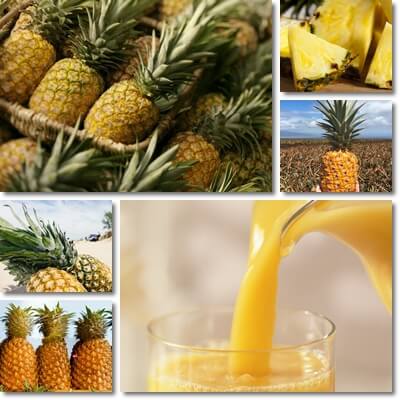If you are diabetic or just looking to manage your blood sugar levels, then the glycemic index score is definitely something to consider when choosing the foods you’re going to eat. The glycemic index score applies to all foods and can even tell you what fruits you can eat or should avoid if you are dealing with high blood sugar or diabetes. Because, believe it or not, there are plenty of healthy, moderate to low-glycemic fruit options to choose from as a diabetic and solutions to reduce their glycemic values and impact on blood sugar metabolism even further. Today, the focus is on pineapple and pineapple juice.
What is the glycemic index?
The glycemic index (GI, for short) is a scale that measures how fast the carbohydrates in a food raise blood sugar levels. Between 0 and 55 is a low GI. Between 55/56 and 69 is a moderate GI. Between 70-100 is a high GI. Diabetics and anyone looking or needing to manage their blood sugar are advised to choose foods with as low a GI as possible.
The lower the GI, the lesser effects on blood sugar metabolism and the better it is for a diabetic or anyone, really. Of course, GI values become irrelevant if intakes are excessive. In case of an excessive intake of a certain food (eating a lot at once), sugars accumulate in the bloodstream and cause spikes, irrespective of how low the GI of said food.

Basically, the glycemic index scale assigns certain numerical values to foods. These numerical values are obtained based on experiments. Essentially, people of different medical backgrounds are offered various foods and their blood sugar levels checked at set intervals afterwards.
The results are often compared with their response to glucose or bread, options that yield high glycemic responses. But experiments don’t always yield the exact same results because of various factors such as state of health, individual responses to various foods, ripeness degree, variety of fruit or vegetable etc. This accounts for the variations in glycemic index values, such as in the case of pineapple and pineapple juice.
Glycemic index of pineapple
Less sweet or slightly less ripe fruit may have a lower GI score, sometimes slightly below 55. The sweeter the variety and riper the fruit, the higher the GI score (usually no more than 66-69, a moderate glycemic index value).
Glycemic index of pineapple juice (unsweetened)
The glycemic index (GI) of unsweetened pineapple juice is 46-56.
In this case, the GI values vary depending on the degree of ripeness of the fruit being juiced and variety (sweeter or less sweet). And yet, the whole fruit is preferred to the juice because it will end up raising blood sugar levels less.

Why is whole pineapple preferred to the juice?
How is it that whole pineapple is better than pineapple juice for blood sugar control and diabetes management? After all, the juice is estimated to have a lower GI score which means it should have a lesser effect on blood sugar which would make it the preferred choice, at least in theory. Well, actually not all pineapple has a GI of 66 – some fruit have a low GI (below 55) which brings them closer to juice GI values.
But the whole fruit also has some dietary fiber – approximately 1.4 g per 100 g of fruit. Dietary fiber is indigestible plant material and one of its effects is to slow the rate of sugar absorption into the bloodstream, contributing to steadier blood sugar levels.
Secondly, whole fruit serving size is a lot smaller than juice serving size (100 g compared to 240-250 g per cup). One juice portion gets you approximately 3 times more carbs than one whole fruit portion. This big a difference in carbohydrate content is sure to cause spikes in blood sugar. And this is the unsweetened juice we’re talking about.
Thirdly, juices don’t satiate and are sweet and particularly palatable which means it’s fairly easy to overindulge and exceed recommended servings and, by extension, carbohydrate limits.
Find out more about whether it is healthier to eat fruits or drink fruit juice.
Other pineapple food options
Then there are also products with added ingredients or pineapple products containing both fruit and juice.
- For example, there is pineapple canned in natural, unsweetened pineapple juice. When you count the carbohydrates in a serving size, you have to consider there is both fruit and juice content.
- If the pineapple is canned in lightly sweetened or heavily sweetened juice, then carbohydrate content goes up by a lot and so does the glycemic score. Consequently, effects on blood sugar will be more pregnant. In this case, serving sizes require adjusting.
- Then there’s sweetened pineapple juice which can easily have a moderate to high glycemic index, depending on the amount of added sugar.
Pineapple and blood sugar
While a bite of pineapple canned in sweetened syrup or a sip of sweetened pineapple juice will not make your blood sugar go sky high then come back crashing down, these are generally products to avoid if you are diabetic or even if you are just watching your blood sugar. Because anything upwards of a certain, rather low intake, will start to affect your blood sugar.
You can, however, enjoy fresh or raw pineapple in moderation. So long as intake is restricted to small portions, of the likes of 100 g of fresh fruit, effects on blood sugar are minimal. This is because the actual content of carbohydrates in such a small serving is quite low (no more than 13, 13.5 g of carbs) and not likely to push blood sugar levels too high.
But even so, remember to eat before having the fruit to reduce its glycemic effects. Ideally, have fruit after a low-carbohydrate meal or with light protein or some fat (example: a piece of cheese or eggs or some chicken). It’s also better to have one fruit at a time and no more than one serving of it a day. This leaves room for variety in your diet and also allows you to better keep count of carbs and manage your blood sugar.
As for the juice, even if the amount of carbs is not that different from that of the whole fruit, consumption is not encouraged. Compared to the whole fruit which is solid and takes some time to be digested, the juice passes through easily and the sugars in it are rapidly taken up, resulting in quick rises in blood sugar levels. Especially on an empty stomach, before a meal. And the more you have at once, the higher the blood sugar rises. Not to mention that it’s too easy to overindulge and exceed safe intakes. Even the typical juice portion size is a cup or 240 ml/g, whereas the typical whole fruit serving is usually around 100 g.
How to lower pineapple juice effects on blood sugar
But if you do want to have pineapple juice, here is how to reduce its effects on blood sugar:
- Only have small portions of the likes of 100 ml at once.
- Limit intake to one serving a day.
- Always choose unsweetened pineapple juice over sweetened and check the label to make sure.
- Never have pineapple juice before a meal. Always eat first, preferably some protein with a little fat and fewer carbs.
- Don’t mix it with other fruits or juices. This amps the glycemic values to unhealthy levels.
- Count your carbs to make sure you keep intake as low as needed to avoid blood sugar fluctuations.
